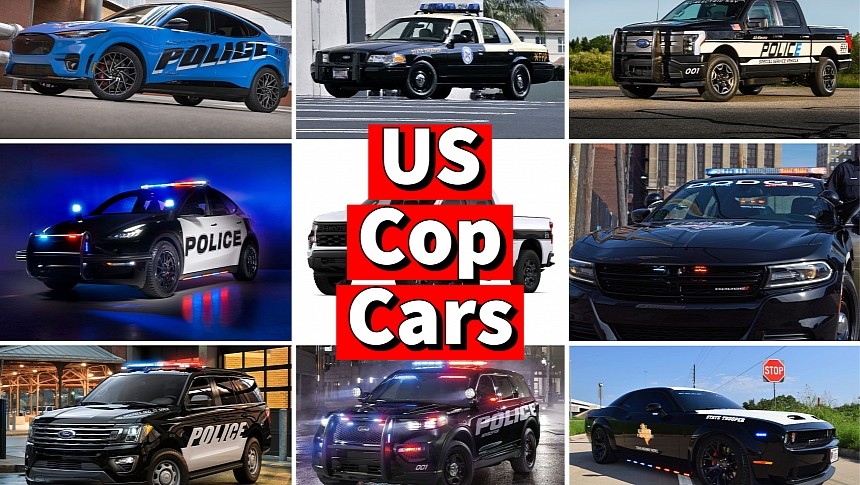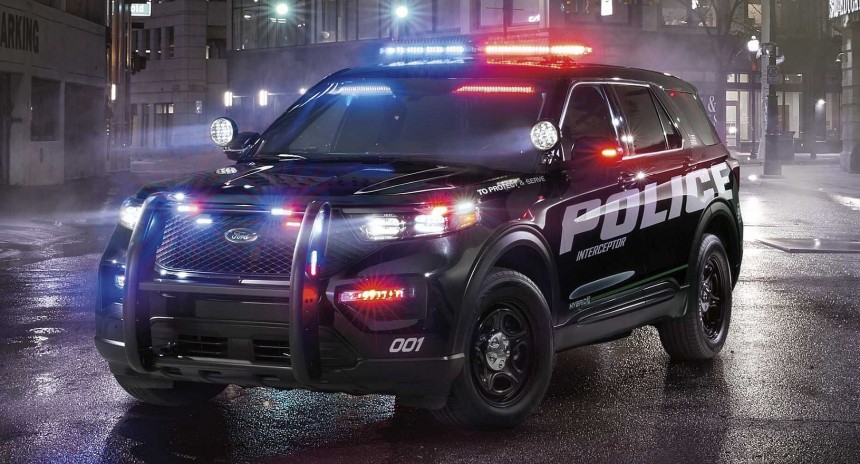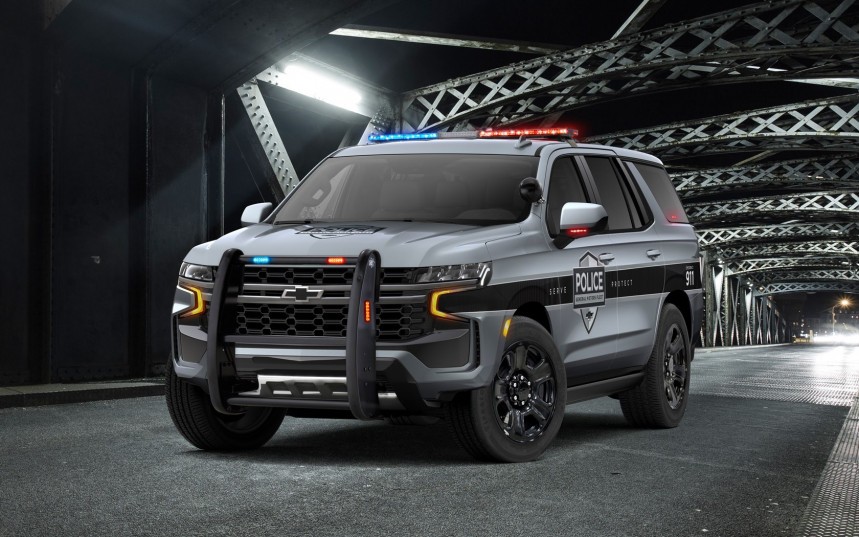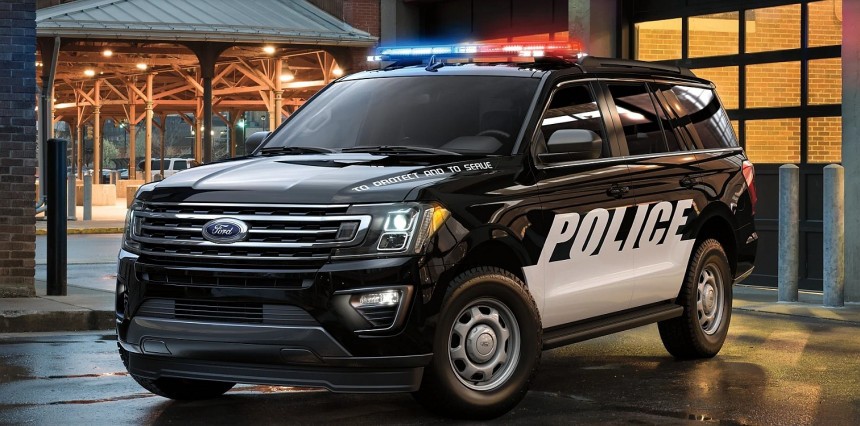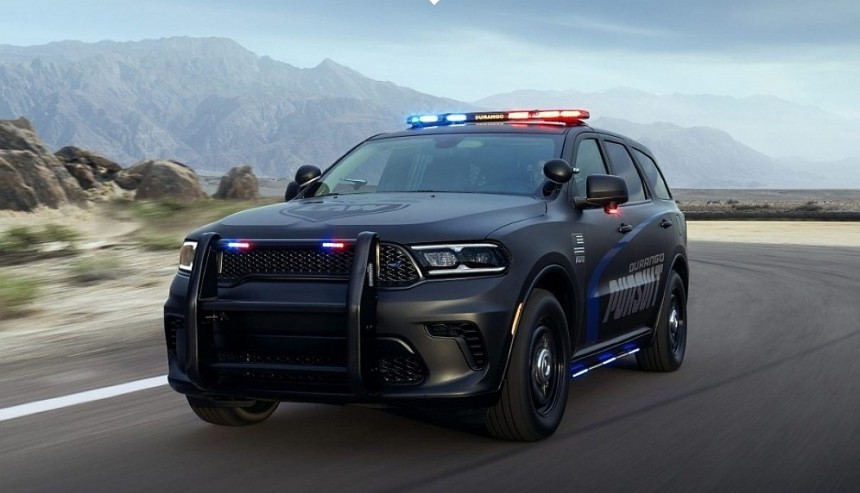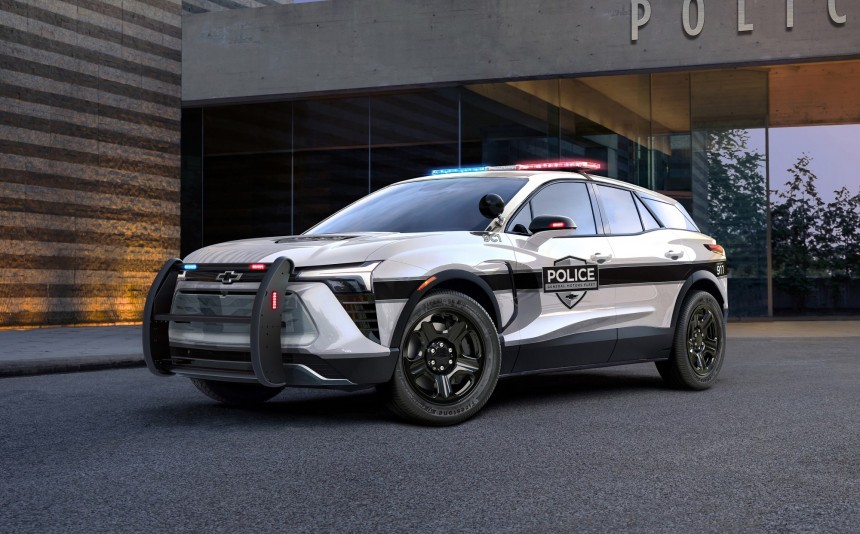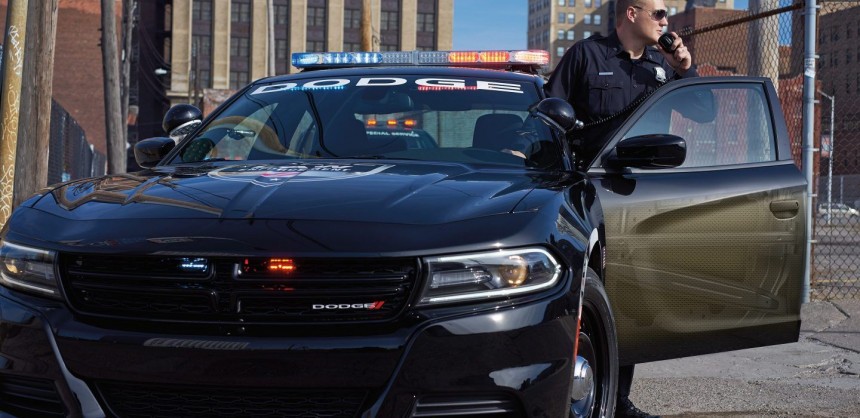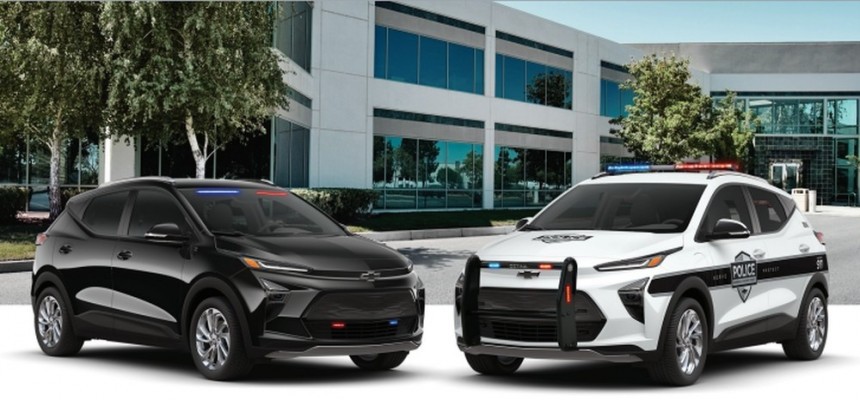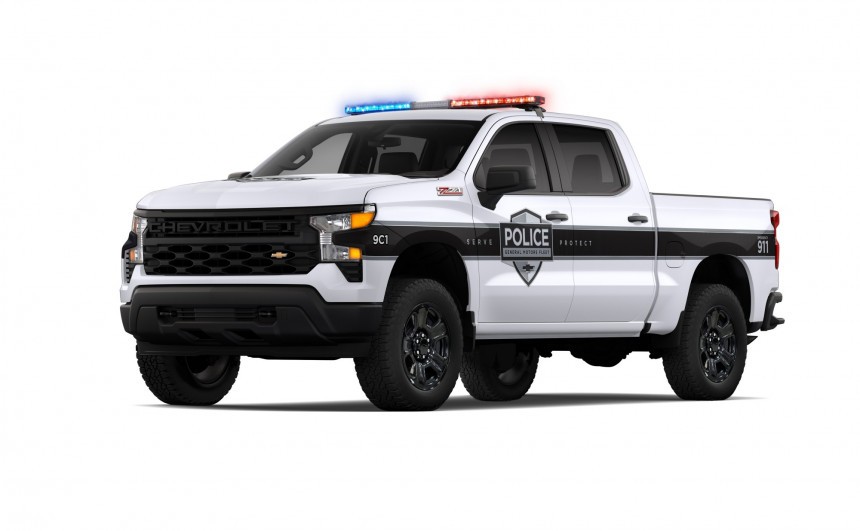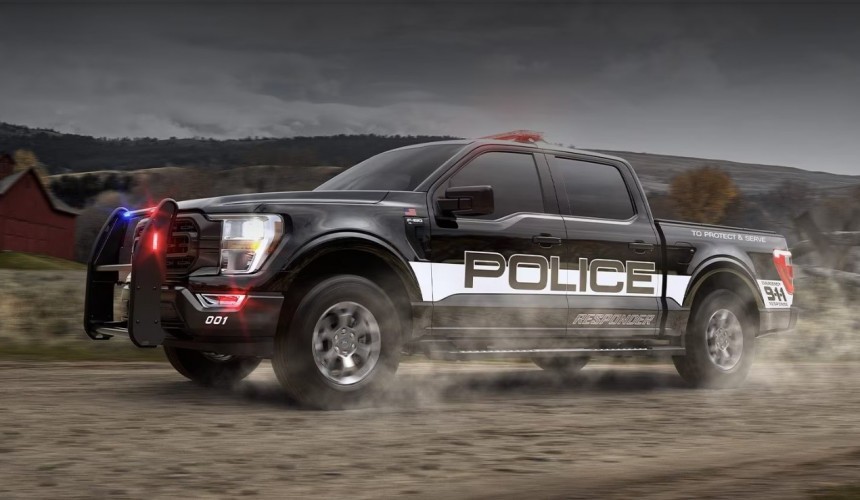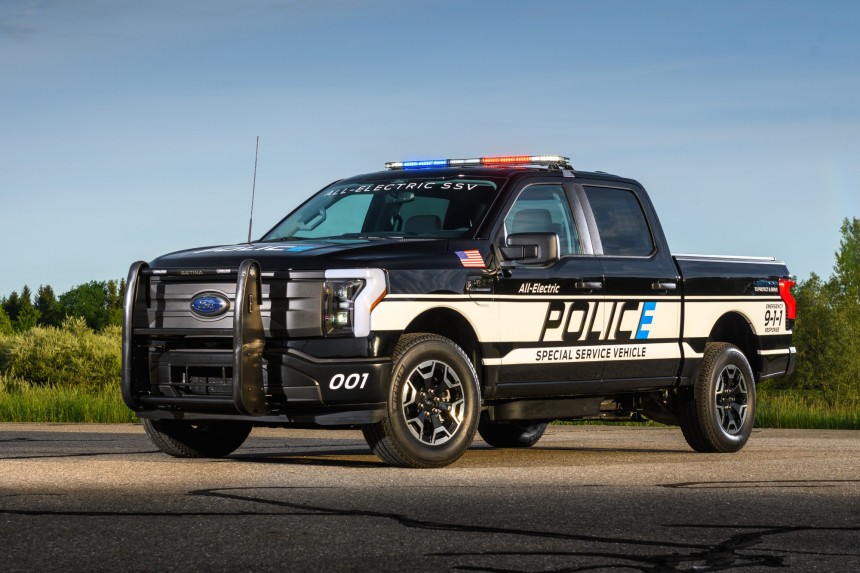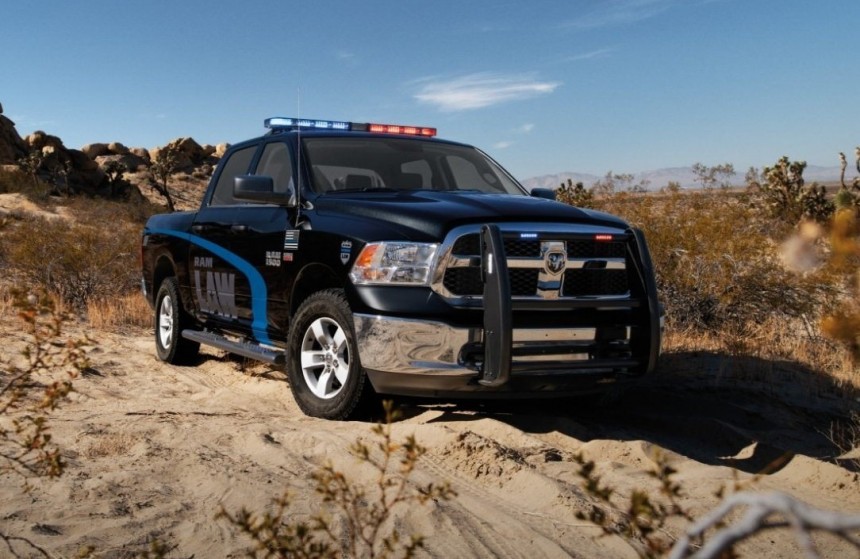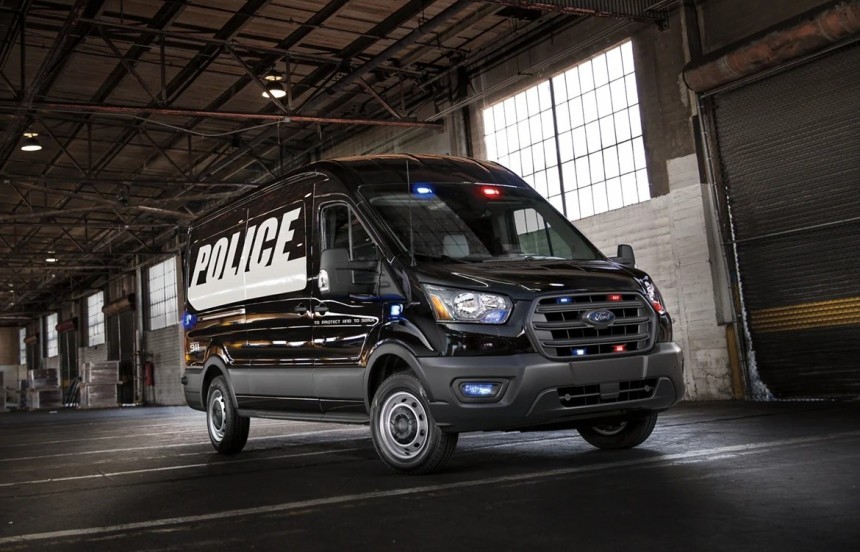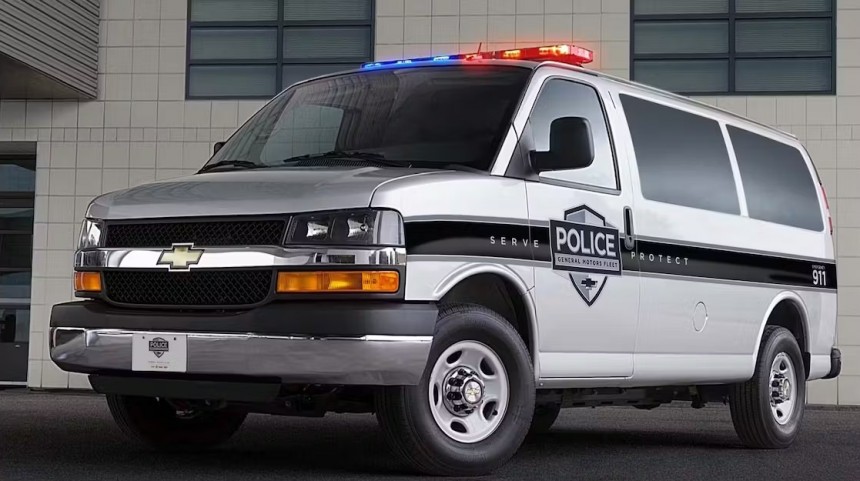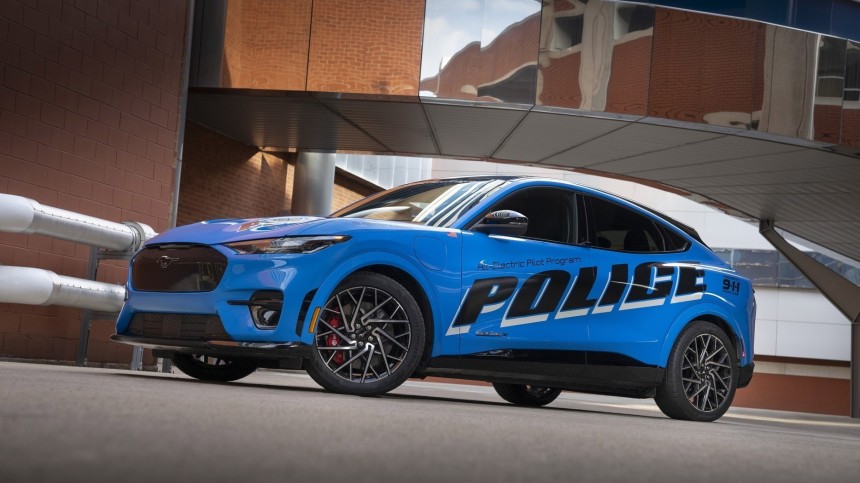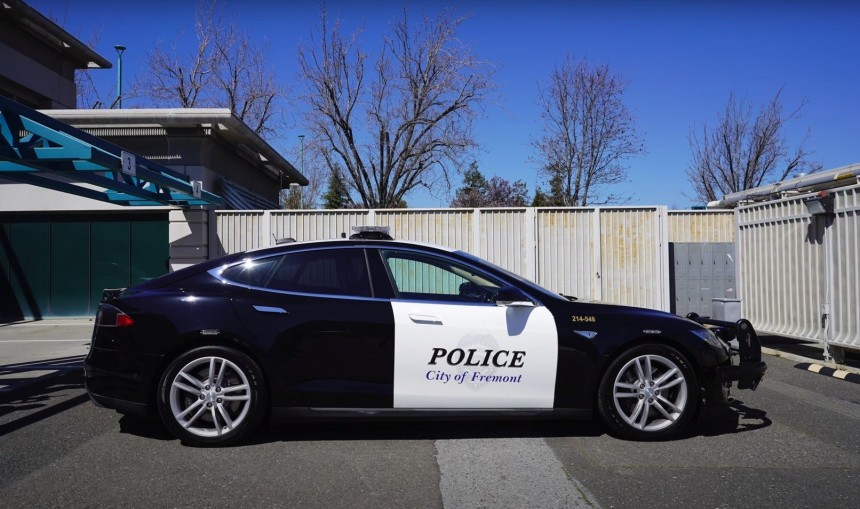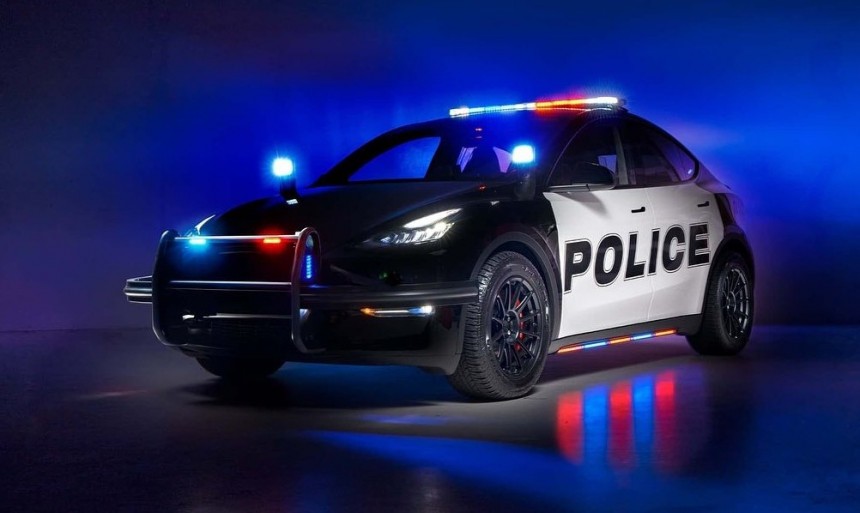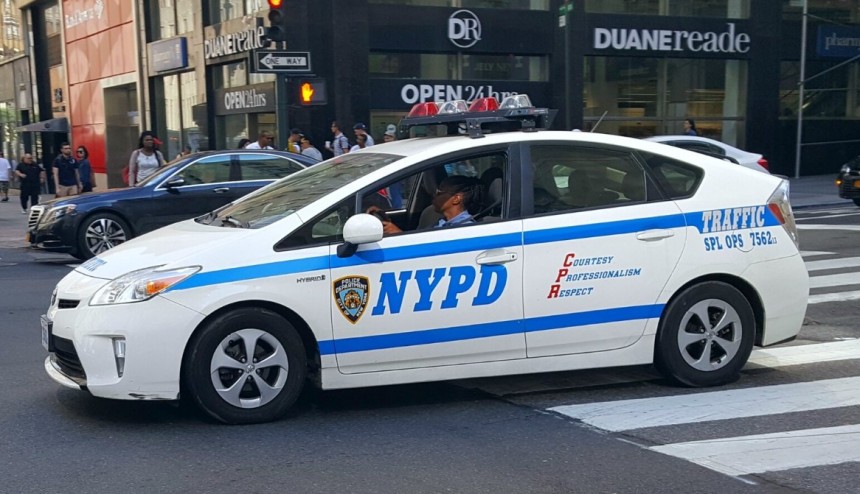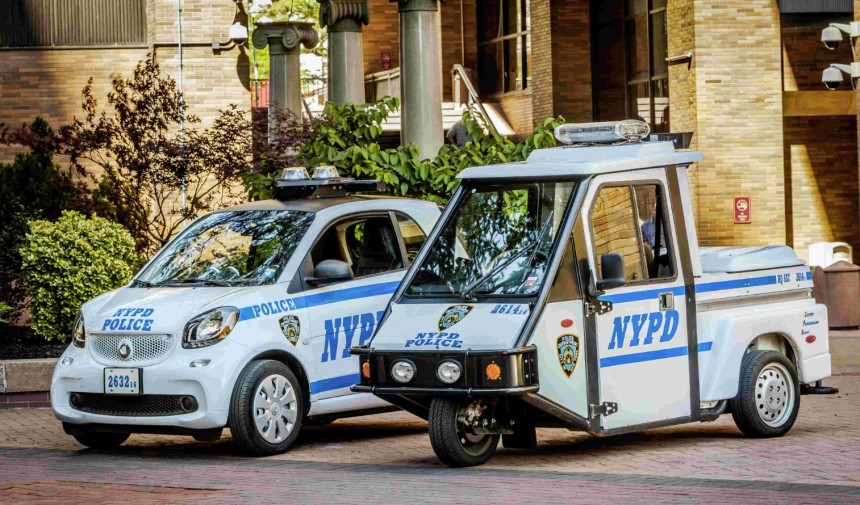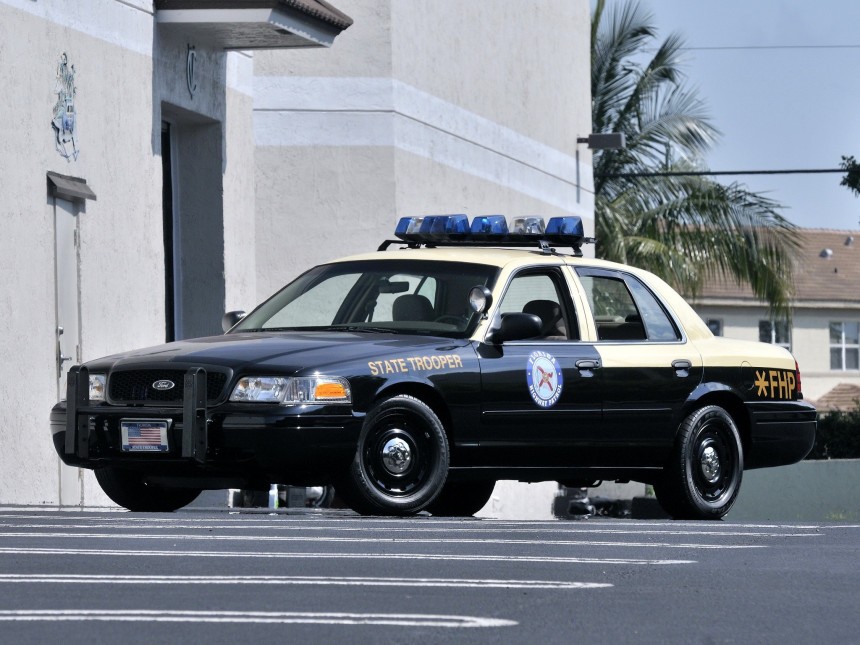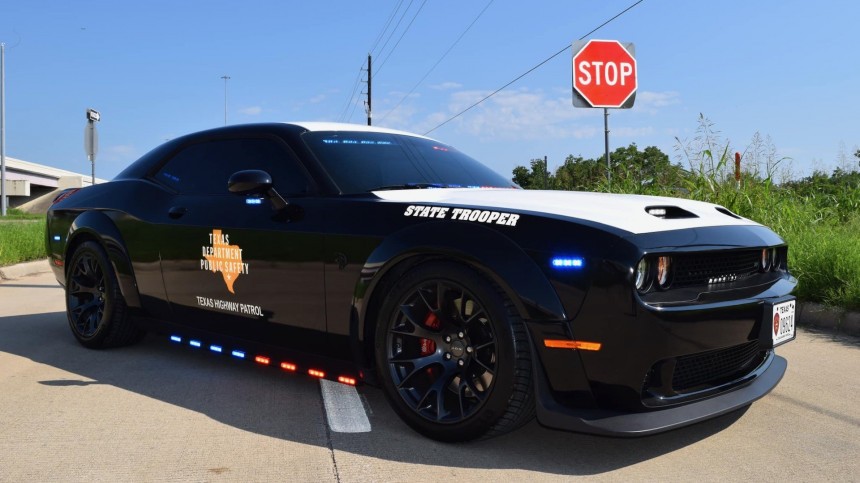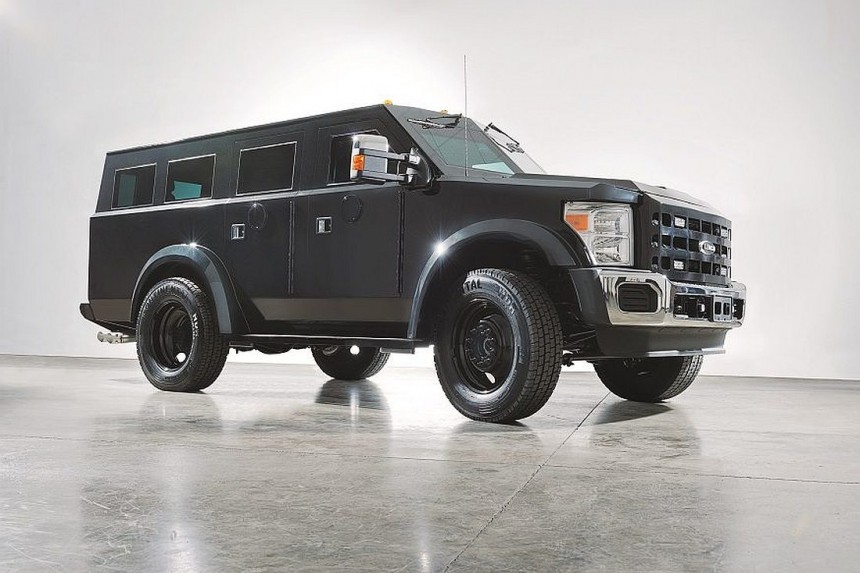Police cars have been around ever since automobiles started becoming mainstream. The first police vehicle dates back to 1899 when the Akron Police Department in Ohio acquired an electric wagon. It could reach 16 mph (26 kph) and travel 30 miles (48 km) on a fully charged battery. As gasoline vehicles took over the industry in the early 20th century, police departments shifted toward ICE power.
More than 100 years have passed since then, and most police vehicles still rely on gasoline to patrol and pursuit criminals. But things have shifted dramatically. The sedan is no longer the most common body style, having been replaced by SUVs. And with the entire industry shifting back to electric power, EVs are slowly but surely "infiltrating" into police departments. Here's a list of the police cars you are likely to encounter in the US nowadays.
The tried-and-true 3.3-liter V6 comes with 285 horsepower on tap, while the hybrid version of the same mill cranks out 318 horses combined. Finally, the twin-turbo 3.0-liter EcoBoost V6 provides higher performance oomph via 400 horsepower and 415 pound-feet (563 Nm) of torque.
How fast can it go? Well, the EcoBoost pushes the heavy hauler from 0 to 60 mph (97 kph) in just 5.5 seconds. Top speed comes in at an impressive 148 mph (238 kph).
The Tahoe is yet another nameplate that's been the SUV of choice for many police departments across the US. And unlike the Explorer, it's been on duty since 1997, when Chevrolet began offering the Z56 police package. Come 2023, the PPV is quite the notable departure from the standard Tahoe.
It features a lower and stiffened suspension, a specially tuned engine and transmission, and standard Brembo brakes. It also uses high-performance rocker covers from the LT4 V8 engine and a dedicated cooling system. The SUV draws juice from the familiar 5.3-liter EcoTec3 mill, producing 355 horsepower.
That's when all eight cylinders are on duty. The mill also features twelve modes of cylinder deactivation for improved fuel efficiency. How fast can the Tahoe PPV go? Charging to 60 mph takes 5.95 seconds, while the top speed is rated at 124 mph (199 kph).
It's available in standard and MAX configurations and is just as off-road capable as the civilian version. The police-duty Expedition is shipped with the turbocharged, 3.5-liter V6 EcoBoost engine, which delivers 400 horsepower and up to 480 pound-feet (651 Nm) of torque.
The body-on-frame SUV's towing capacity of up to 9,300 pounds (4,218 kg) and GCWR of up to 15,100 pounds (6,849 kg) comes in handy when hauling cargo for special missions. Ford says it features a "cop-smart interior" devoid of a column shifter, and the floor is covered in easy-to-clean vinyl. Just in case things get messy, you know?
Dodge doesn't have an SUV the size of the Expedition, but it gained access to a piece of the special service and police pie via a Pursuit version of the Durango. Introduced in 2019, the Mopar hauler tackled the law enforcement market with AWD and a selection of V6 and V8 powerplants.
The 3.6-liter V6 Pentastar comes standard, giving officers 290 horsepower and 258 pound-feet (350 Nm) of torque to work with. The available 5.7-liter HEMI V8 cranks out a healthier 360 horsepower and 390 pound-feet (530 Nm) of twist, also through an AWD system. It's not as quick as the Ford Explorer, but it boasts a more menacing stance overall.
Police-spec upgrades include a performance-tuned suspension, heavy-duty brakes, vinyl floors, and bespoke front seats designed to accommodate a full-service duty belt.
And it has quite a powerful drivetrain to brag about. Fitted with two electric motors, the Blazer EV PPV has 498 horsepower and 531 pound-feet of twist to play with. These figures not only make it the most powerful production police-spec SUV as of August 2023 but also the quickest.
Specifically, it needs less than four seconds to hit the magical 60-mph benchmark, and that's more than a second quicker than the Ford Explorer. The 105-kWh battery pack enables it to drive for about 250 miles (402 km) on a full battery.
Introduced in 2006 as the Police Package, the Charger Pursuit is currently the most popular police car. The four-door sedan was renamed the Pursuit when the Charger was redesigned for the 2011 model year. It effectively replaced the Ford Crown Victoria Police Interceptor as the top police sedan in North America following the latter discontinuation.
By 2017, the Charger Pursuit became so popular that it began to challenge the Ford Explorer's top-selling spot. As of 2023, the Charger Pursuit shares engine options with the Durango Pursuit, so there's a standard 3.6-liter Pentastar and an optional 5.7-liter HEMI. However, the latter is RWD only on the sedan. Equipped with four-wheel disc brakes, the Pursuit is optionally available with NIJ level III ballistic door panels.
Capable of reaching 60 mph in 4.9 seconds, the Charger Pursuit is the quickest ICE police car as of this writing. It's also the fastest non-electric interceptor.
While US law enforcement usually relies on large SUVs and sedans, some police departments use smaller vehicles on missions that don't require spacious interiors and big power. The Chevrolet Bolt SSV was designed specifically for this role.
Available in both EV and EUV versions via GM's fleet catalog, the Bolt SSV looks much friendlier than its massive Tahoe sibling. Don't let that fool you, though: it comes with a full police-spec package that includes 20- and 30-amp circuits and a Surveillance Mode that turns all lights off.
Just like the regular Bolt, the SSV packs an electric motor good for 201 horsepower and a battery that returns up to 259 miles (417 km) on a full charge. It's not the kind of police car you'll see chasing muscle cars on the highway, though, as the Bolt hits a top speed of only 93 mph (150 kph).
Well, of course the US police use pickup trucks! It's Murica! Chevy's most popular hauler with a bed, the Silverado 1500, joined the SSV ranks in 2014, over a decade after Chevy introduced the LSSV military truck.
Come 2023 and police departments can purchase the latest-generation truck with beefed-up brakes, 20-inch steel wheels shared with the Tahoe PPV, and a heavy-duty air filter. The truck also has the Z71 off-road package and a small-block V8 engine good for 355 horsepower and 383 pound-feet (518 Nm) of torque.
The Silverado PPV has auxiliary wiring circuits, a surveillance circuit, five upfitter switches, standard headlamp, and taillight flashers. The truck's towing capacity is identical to the Ford Expedition at 9,300 pounds.
As you might have already guessed, Ford offers its own F-150 pickup truck with a police-rated package. Introduced in 2017 as the Police Responder and described as "the first-ever pursuit-rated police pickup," the law enforcement hauler got a serious update in 2021.
Based on the fourteenth-generation SuperCrew, the latest Police Responder packs a 3.5-liter EcoBoost V6 rated at 400 horsepower and hits a top speed of 120 mph (193 kph). The truck features the FX4 Off-Road Package as standard, which adds underbody skid plates, off-road shocks, a locking rear axle, and the Hill Descent Control assist function.
The F-150's 7,000-pound (3,175-kg) towing capacity is inferior to that of the Silverado PPV, but it's more than enough for departments to haul equipment like mobile command centers and boats. However, Ford offers the Trailer Two Package on the Police Responder, and the bundle increases the towing capacity to an impressive 11,200 pounds (5,080 kg).
Drivetrain options are similar to the regular-production Lightning. The base configuration gives the truck a 452-horsepower power rating, a 230-mile (370-km) range, and a towing capacity of 7,700 pounds (3,493 kg). Departments that go with the bigger battery stack get 558 horsepower, 300 miles (483 km) per full charge, and a towing capacity of 10,000 pounds (4,536 kg).
With an estimated sprint to 60 mph in less than four seconds, the Lightning is among the fastest police vehicles on the market right now.
Well, it's common practice for fleet departments to keep older vehicles in service. It's pretty much what Ford did with the Crown Vic for a few years. But that's not to say that the 1500 Classic is dated for special service duty.
The truck has many modern features, including traction and stability control, Uconnect, and a 10-way power driver seat. Police-spec features include a folding vinyl rear bench, in-floor storage bins, a 220-amp alternator, and additional key fobs. Power comes from the ubiquitous 5.7-liter HEMI V8 that provides a towing capacity of up to 10,220 pounds (4,636 kg).
Much like the civilian version, it's available in three roof heights, three lengths, and two wheelbases. However, this van can also be customized to include single, double, or triple prisoner-transport inserts.
The van comes with a choice of two V6 engines, including a naturally aspirated mill good for 275 horsepower and an EcoBoost rated at 310 horses. All-wheel drive is optional.
Arguably the oldest vehicle still available for purchase, the Chevrolet Express serves a different purpose than the Transit. While the latter is advertised as a prisoner transport vehicle, the Express is available to police departments as a personnel hauler.
It can seat up to 15 people, making it far more practical than a truck or SUV, and it's available with three engines. The 276-horsepower V6 comes standard, but customers can also go with a 2.8-liter turbodiesel four-cylinder (181 horses) and a 6.6-liter V8 that cranks out an impressive 401 horsepower.
And even though it's been in production with modest design updates since 1995, the Express is equipped with a long list of modern features.
No, Ford doesn't actually offer a police-rated version of the Mustang Mach-E. But that didn't stop the New York Police Department from making its own version.
Showcased at the 2022 New York Auto Show, the Mach-E police car is already roaming the streets in blue livery and bright lights on its roof. The 100-unit fleet also includes range-topping GT conversions, which crank out 480 horsepower and 634 pound-feet (860 Nm) of torque.
These SUVs need only 3.8 seconds to hit 60 mph from a standing start and hit a top speed of 124 mph (200 kph). The Mach-E can travel for 211 to 300 miles (340 to 483 km) depending on battery and motor layout.
As America's most popular EV, it was only a matter of time before the Tesla Model S joined police departments. Just like the Mach-E, there's no police-spec Model S available as a fleet vehicle, but several units have already been modified for law enforcement duty.
The Fremont Police Department was among the first to build one in 2019, but the Model S has since found its way into a few other precincts.
As you might have already guessed, a few Model S sedans are on police duty in California. These EVs are also used on a small scale in Dearborn, New York, and Boulder City.
The Model Y is a bit more widespread than the Model S, which makes sense given that it offers a bit more room inside the cabin. The Somerset PD was one of the first police departments to buy a Model Y to use as a patrol car. At the same time, the South Pasadena PD recently purchased a fleet of 10 vehicles.
Model Y conversions are also available from a company called Model PD. Based in Cincinnati, the company offers full conversions that include a push bumper, a secure backseat, steel wheels, police-grade tires, and integrated police lighting. Model PD also ditched the glass roof for a carbon-fiber panel and added tougher upholstery and floor materials inside the cabin.
As for the infotainment system, it's been upgraded with a Windows-based version that comes with a swiveling keyboard. But Model PD isn't the only company building turn-key Model Y police cars. Unplugged Performance also introduced a law enforcement variant in 2023. This one features similar upgrades and an integrated laptop in front of the passenger seat.
Sure, it's not the fastest and most powerful police car out there, but it's mainly used for low-speed patrolling in residential areas. Around since 1997, the Prius has been redesigned four times since its introduction. The latest, fifth-gen hybrid has yet to serve as a police car, though.
Most departments use third- and fourth-generation cars. Both pair 1.8-liter Atkinson-cycle gasoline engines to electric motors. The fourth-gen car is obviously the more advanced one, featuring a dual motor-generator setup and a total output of 120 horsepower.
The NYPD began using the ForTwo in 2016 as a replacement for its three-wheel motorbikes. The department reportedly worked out a deal with Smart USA for no fewer than 250 units. What made the city car appealing to law enforcers? Well, believe it or not, it was space. Because while the Fortwo has a cramped interior compared to other vehicles, it offers way more room than the three-wheel motorbikes the NYPD had used for over a decade.
There's no special "cop motor" in these cars, but the NYPD went with the more powerful and turbocharged 0.9-liter three-cylinder, rated at 89 horsepower. Police-rated features include a revolving roof lamp and radio equipment.
The Crown Victoria became available as a police car in 1992, one year after the civilian version hit the market. It was created specifically to compete with the police-rated Chevrolet Caprice. And after the discontinuation of the latter in 1996, the Crown Victoria dominated police fleet sales for more than a decade.
The CVPI came with many heavy-duty components, including a revised transmission and a beefed-up V8 engine. Both generations were powered by the iconic 4.6-liter "Modular" V8. Initially rated at 215 horsepower, the lump came with 235 horses on tap in 2001. Ford upgraded the mill to 239 horsepower in 2003 and 250 horses in 2004. The Crown Vic hit 60 mph in less than eight seconds and peaked at 129 mph (208 kph). Its top speed was electronically limited.
Ford stopped taking orders for the CVPI in 2011, a few months before the civilian Crown Victoria was discontinued. In addition to being dated in many departments, the Crown Vic was no longer legal for sale in the US and Canada due to the lack of an electronic stability control system. It was replaced by the Interceptor Sedan, based on the Taurus.
Fitted with police lights in the grille, windshield, and fender vents, the Corvette also wears a green, white, and yellow livery. It kind of looks like a Hotwheels toy, but that doesn't matter since this Z06 isn't used as a patrol vehicle. Instead, the 650-horsepower sports car shows up at various community events. Needless to say, you really don't have to worry about seeing it in your rearview mirror.
It's not a Demon 170 in disguise, but it's pretty close, thanks to a long list of upgrades under the hood. And no, it's not the product of a special police workshop. Just like the Corvette Z06 above, this beefed-up Hellcat was confiscated from a criminal suspect.
The muscle car was introduced to the world in 2022 through a social media post that read, "The 1,080 hp Dodge Hellcat went from evading law enforcement in Harris Co. to now catching criminals wherever it roams in Texas." It's the most powerful and quickest police car in the US right now, and a great way to end our list of cop rigs you may encounter.
FBI agents use US Government fleet vehicles, so most of them are similar to police cruisers. These include Ford, Dodge, and Chevrolet cars and SUVs (possibly trucks too). However, the FBI fleet also includes special rigs like the Lenco BearCat.
This armored truck was introduced in 2001 and comes in various shapes for military, diplomatic, medical, and bomb-squad purposes. It's among the most expensive law enforcement vehicles, costing up to $300,000 a pop.
Ford Explorer Police Interceptor
Arguably the most popular police vehicle since the Crown Victoria was discontinued, the Explorer Police Interceptor is now widely used across the US. Now in its second generation, the police-spec SUV has three engines covering the naturally aspirated, twin-turbo, and hybrid realms.The tried-and-true 3.3-liter V6 comes with 285 horsepower on tap, while the hybrid version of the same mill cranks out 318 horses combined. Finally, the twin-turbo 3.0-liter EcoBoost V6 provides higher performance oomph via 400 horsepower and 415 pound-feet (563 Nm) of torque.
How fast can it go? Well, the EcoBoost pushes the heavy hauler from 0 to 60 mph (97 kph) in just 5.5 seconds. Top speed comes in at an impressive 148 mph (238 kph).
Chevrolet Tahoe PPV
It features a lower and stiffened suspension, a specially tuned engine and transmission, and standard Brembo brakes. It also uses high-performance rocker covers from the LT4 V8 engine and a dedicated cooling system. The SUV draws juice from the familiar 5.3-liter EcoTec3 mill, producing 355 horsepower.
That's when all eight cylinders are on duty. The mill also features twelve modes of cylinder deactivation for improved fuel efficiency. How fast can the Tahoe PPV go? Charging to 60 mph takes 5.95 seconds, while the top speed is rated at 124 mph (199 kph).
Ford Expedition SSV
We're back into Ford territory with an even larger SUV, the Expedition. Initially developed after Chevrolet introduced a police version of the Suburban, the Expedition SSV is the largest Ford-badged police hauler that's not a van.It's available in standard and MAX configurations and is just as off-road capable as the civilian version. The police-duty Expedition is shipped with the turbocharged, 3.5-liter V6 EcoBoost engine, which delivers 400 horsepower and up to 480 pound-feet (651 Nm) of torque.
The body-on-frame SUV's towing capacity of up to 9,300 pounds (4,218 kg) and GCWR of up to 15,100 pounds (6,849 kg) comes in handy when hauling cargo for special missions. Ford says it features a "cop-smart interior" devoid of a column shifter, and the floor is covered in easy-to-clean vinyl. Just in case things get messy, you know?
Dodge Durango Pursuit
The 3.6-liter V6 Pentastar comes standard, giving officers 290 horsepower and 258 pound-feet (350 Nm) of torque to work with. The available 5.7-liter HEMI V8 cranks out a healthier 360 horsepower and 390 pound-feet (530 Nm) of twist, also through an AWD system. It's not as quick as the Ford Explorer, but it boasts a more menacing stance overall.
Police-spec upgrades include a performance-tuned suspension, heavy-duty brakes, vinyl floors, and bespoke front seats designed to accommodate a full-service duty belt.
Chevrolet Blazer EV PPV
Our final entry on the SUV list is the Chevrolet Blazer EV. That's right, police pursuit vehicles are also going electric. It may take a while until all law-enforcement departments give up on their ICE vehicles, but the Blazer EV is already knocking on every police precinct door.And it has quite a powerful drivetrain to brag about. Fitted with two electric motors, the Blazer EV PPV has 498 horsepower and 531 pound-feet of twist to play with. These figures not only make it the most powerful production police-spec SUV as of August 2023 but also the quickest.
Specifically, it needs less than four seconds to hit the magical 60-mph benchmark, and that's more than a second quicker than the Ford Explorer. The 105-kWh battery pack enables it to drive for about 250 miles (402 km) on a full battery.
Dodge Charger Pursuit
By 2017, the Charger Pursuit became so popular that it began to challenge the Ford Explorer's top-selling spot. As of 2023, the Charger Pursuit shares engine options with the Durango Pursuit, so there's a standard 3.6-liter Pentastar and an optional 5.7-liter HEMI. However, the latter is RWD only on the sedan. Equipped with four-wheel disc brakes, the Pursuit is optionally available with NIJ level III ballistic door panels.
Capable of reaching 60 mph in 4.9 seconds, the Charger Pursuit is the quickest ICE police car as of this writing. It's also the fastest non-electric interceptor.
Chevrolet Bolt SSV
Available in both EV and EUV versions via GM's fleet catalog, the Bolt SSV looks much friendlier than its massive Tahoe sibling. Don't let that fool you, though: it comes with a full police-spec package that includes 20- and 30-amp circuits and a Surveillance Mode that turns all lights off.
Just like the regular Bolt, the SSV packs an electric motor good for 201 horsepower and a battery that returns up to 259 miles (417 km) on a full charge. It's not the kind of police car you'll see chasing muscle cars on the highway, though, as the Bolt hits a top speed of only 93 mph (150 kph).
Chevrolet Silverado PPV
Come 2023 and police departments can purchase the latest-generation truck with beefed-up brakes, 20-inch steel wheels shared with the Tahoe PPV, and a heavy-duty air filter. The truck also has the Z71 off-road package and a small-block V8 engine good for 355 horsepower and 383 pound-feet (518 Nm) of torque.
The Silverado PPV has auxiliary wiring circuits, a surveillance circuit, five upfitter switches, standard headlamp, and taillight flashers. The truck's towing capacity is identical to the Ford Expedition at 9,300 pounds.
Ford F-150 Police Responder
Based on the fourteenth-generation SuperCrew, the latest Police Responder packs a 3.5-liter EcoBoost V6 rated at 400 horsepower and hits a top speed of 120 mph (193 kph). The truck features the FX4 Off-Road Package as standard, which adds underbody skid plates, off-road shocks, a locking rear axle, and the Hill Descent Control assist function.
The F-150's 7,000-pound (3,175-kg) towing capacity is inferior to that of the Silverado PPV, but it's more than enough for departments to haul equipment like mobile command centers and boats. However, Ford offers the Trailer Two Package on the Police Responder, and the bundle increases the towing capacity to an impressive 11,200 pounds (5,080 kg).
Ford F-150 Lightning Pro SSV
Now that Ford also has an all-electric F-150, it was only natural for the zero-emissions truck to get a Special Service Vehicle version. The Lightning comes with pretty much the same police-grade equipment as the F-150 Responder but with the advantages of a fully electric rig.Drivetrain options are similar to the regular-production Lightning. The base configuration gives the truck a 452-horsepower power rating, a 230-mile (370-km) range, and a towing capacity of 7,700 pounds (3,493 kg). Departments that go with the bigger battery stack get 558 horsepower, 300 miles (483 km) per full charge, and a towing capacity of 10,000 pounds (4,536 kg).
With an estimated sprint to 60 mph in less than four seconds, the Lightning is among the fastest police vehicles on the market right now.
Ram 1500 SSV
The third Mopar serving law enforcement comes from the Ram Trucks division. But unlike pickups from Chevrolet and Ford, this one's pretty old. That's because it's based on the fourth-gen 1500, which was replaced in 2019. Why is Ram still offering a relatively dated truck?Well, it's common practice for fleet departments to keep older vehicles in service. It's pretty much what Ford did with the Crown Vic for a few years. But that's not to say that the 1500 Classic is dated for special service duty.
The truck has many modern features, including traction and stability control, Uconnect, and a 10-way power driver seat. Police-spec features include a folding vinyl rear bench, in-floor storage bins, a 220-amp alternator, and additional key fobs. Power comes from the ubiquitous 5.7-liter HEMI V8 that provides a towing capacity of up to 10,220 pounds (4,636 kg).
Ford Transit Prisoner Transport Vehicle
While not as common as cars, SUVs, and trucks, vans are also part of many police departments across the US. Introduced in 2019, the Transit serves as a prisoner transport vehicle, but it's not necessarily limited to this purpose.Much like the civilian version, it's available in three roof heights, three lengths, and two wheelbases. However, this van can also be customized to include single, double, or triple prisoner-transport inserts.
The van comes with a choice of two V6 engines, including a naturally aspirated mill good for 275 horsepower and an EcoBoost rated at 310 horses. All-wheel drive is optional.
Chevrolet Express Transport Van
It can seat up to 15 people, making it far more practical than a truck or SUV, and it's available with three engines. The 276-horsepower V6 comes standard, but customers can also go with a 2.8-liter turbodiesel four-cylinder (181 horses) and a 6.6-liter V8 that cranks out an impressive 401 horsepower.
And even though it's been in production with modest design updates since 1995, the Express is equipped with a long list of modern features.
Ford Mustang Mach-E
Showcased at the 2022 New York Auto Show, the Mach-E police car is already roaming the streets in blue livery and bright lights on its roof. The 100-unit fleet also includes range-topping GT conversions, which crank out 480 horsepower and 634 pound-feet (860 Nm) of torque.
These SUVs need only 3.8 seconds to hit 60 mph from a standing start and hit a top speed of 124 mph (200 kph). The Mach-E can travel for 211 to 300 miles (340 to 483 km) depending on battery and motor layout.
Tesla Model S
The Fremont Police Department was among the first to build one in 2019, but the Model S has since found its way into a few other precincts.
As you might have already guessed, a few Model S sedans are on police duty in California. These EVs are also used on a small scale in Dearborn, New York, and Boulder City.
Tesla Model Y
Model Y conversions are also available from a company called Model PD. Based in Cincinnati, the company offers full conversions that include a push bumper, a secure backseat, steel wheels, police-grade tires, and integrated police lighting. Model PD also ditched the glass roof for a carbon-fiber panel and added tougher upholstery and floor materials inside the cabin.
As for the infotainment system, it's been upgraded with a Windows-based version that comes with a swiveling keyboard. But Model PD isn't the only company building turn-key Model Y police cars. Unplugged Performance also introduced a law enforcement variant in 2023. This one features similar upgrades and an integrated laptop in front of the passenger seat.
Toyota Prius
Naturally, hybrids were the first electrified cars to join police stations. The Prius isn't the only one, but you'll find it wearing police livery and lights quite often around the Manhattan area.Sure, it's not the fastest and most powerful police car out there, but it's mainly used for low-speed patrolling in residential areas. Around since 1997, the Prius has been redesigned four times since its introduction. The latest, fifth-gen hybrid has yet to serve as a police car, though.
Most departments use third- and fourth-generation cars. Both pair 1.8-liter Atkinson-cycle gasoline engines to electric motors. The fourth-gen car is obviously the more advanced one, featuring a dual motor-generator setup and a total output of 120 horsepower.
Smart ForTwo
Did I hear anyone ask what's the smallest police car in the US? That would have to be the Smart ForTwo. You'll have to travel to New York to see one, though, as the tiny German city car is not exactly common in police overalls.The NYPD began using the ForTwo in 2016 as a replacement for its three-wheel motorbikes. The department reportedly worked out a deal with Smart USA for no fewer than 250 units. What made the city car appealing to law enforcers? Well, believe it or not, it was space. Because while the Fortwo has a cramped interior compared to other vehicles, it offers way more room than the three-wheel motorbikes the NYPD had used for over a decade.
There's no special "cop motor" in these cars, but the NYPD went with the more powerful and turbocharged 0.9-liter three-cylinder, rated at 89 horsepower. Police-rated features include a revolving roof lamp and radio equipment.
Ford Crown Victoria Police Interceptor
Arguably the most legendary police car in history, the Crown Vic Interceptor was officially discontinued in 2011. Most police departments have since replaced it with more modern rigs, but the Crown Vic still roams on public roads with police badges and roof lights. Dozens of cars are still in service in the San Francisco and Las Vegas areas, but they've been spotted in Florida, Kansas, and Indianapolis as well. It turns out that at least one is still in use in Hawaii as well.The Crown Victoria became available as a police car in 1992, one year after the civilian version hit the market. It was created specifically to compete with the police-rated Chevrolet Caprice. And after the discontinuation of the latter in 1996, the Crown Victoria dominated police fleet sales for more than a decade.
The CVPI came with many heavy-duty components, including a revised transmission and a beefed-up V8 engine. Both generations were powered by the iconic 4.6-liter "Modular" V8. Initially rated at 215 horsepower, the lump came with 235 horses on tap in 2001. Ford upgraded the mill to 239 horsepower in 2003 and 250 horses in 2004. The Crown Vic hit 60 mph in less than eight seconds and peaked at 129 mph (208 kph). Its top speed was electronically limited.
Ford stopped taking orders for the CVPI in 2011, a few months before the civilian Crown Victoria was discontinued. In addition to being dated in many departments, the Crown Vic was no longer legal for sale in the US and Canada due to the lack of an electronic stability control system. It was replaced by the Interceptor Sedan, based on the Taurus.
One-Off Specials
What's a police-spec one-off special? Well, remember when the LAPD got a Lamborghini Gallardo in 2014? That's the type of vehicle I'm talking about. But I'm not here to talk about the supercar that the LAPD got as a donation. The Gallardo is no longer in service. But here are a few special "interceptors" that still roam the streets.Chevrolet Corvette Z06
Much like a Lamborghini, the Corvette is a decidedly unpractical car for police duty. But that didn't stop the Escambia County Sheriff's Office from getting one. But before you complain about the police department spending taxpayer's money on things it shouldn't, you should know the C7-generation Z06 was seized from a felony suspect.Fitted with police lights in the grille, windshield, and fender vents, the Corvette also wears a green, white, and yellow livery. It kind of looks like a Hotwheels toy, but that doesn't matter since this Z06 isn't used as a patrol vehicle. Instead, the 650-horsepower sports car shows up at various community events. Needless to say, you really don't have to worry about seeing it in your rearview mirror.
Dodge Challenger SRT Hellcat
If you plan to do a record-setting speed run on highways in Texas, you'd better think again. The Texas Highway Patrol has a Dodge Challenger SRT Hellcat ready to chase any supercar regardless of oomph and speed. And before you say the 707-horsepower Hellcat is not potent enough for modern hypercars, you need to know this Mopar actually cranks out a whopping 1,080 horsepower.It's not a Demon 170 in disguise, but it's pretty close, thanks to a long list of upgrades under the hood. And no, it's not the product of a special police workshop. Just like the Corvette Z06 above, this beefed-up Hellcat was confiscated from a criminal suspect.
The muscle car was introduced to the world in 2022 through a social media post that read, "The 1,080 hp Dodge Hellcat went from evading law enforcement in Harris Co. to now catching criminals wherever it roams in Texas." It's the most powerful and quickest police car in the US right now, and a great way to end our list of cop rigs you may encounter.
What Cars Does the FBI Use?
Due to the stealthy nature of most FBI missions, the Bureau rarely uses intimidating vehicles with flashy lights and loud sirens. The feds usually drive unmarked cars with either Government or regular state-issued license plates.FBI agents use US Government fleet vehicles, so most of them are similar to police cruisers. These include Ford, Dodge, and Chevrolet cars and SUVs (possibly trucks too). However, the FBI fleet also includes special rigs like the Lenco BearCat.
This armored truck was introduced in 2001 and comes in various shapes for military, diplomatic, medical, and bomb-squad purposes. It's among the most expensive law enforcement vehicles, costing up to $300,000 a pop.
